Stimulating muscle fibers with magnets causes them to grow in the same direction, aligning muscle cells within tissue, Massachusetts Institute of Technology (MIT) and Boston University investigators report October 20 in the journal Device. The findings offer a simpler, less time-consuming way for medical researchers to program muscle cell alignment, which is strongly tied to healthy muscle function.
“The ability to make aligned muscle in a lab setting means that we can develop model tissues for understanding muscle in healthy and diseased states and for developing and testing new therapies that combat muscle injury or disease,” says senior author Ritu Raman (@DrRituRaman), an MIT engineer. A better understanding of the rules that govern muscle growth could also have applications in robotics, she adds.
In a previous investigation, Raman and colleagues found that “exercising” muscle fibers by making them contract in response to electrical stimulation for 30 minutes a day over the course of 10 days made the fibers stronger. This time, the researchers wanted to explore whether mechanically stimulating the muscle fibers over the same time frame (rather than letting them respond on their own) would have the same result. To investigate, they developed a method to mechanically stimulate muscle tissue that differs from typical lab techniques.
Generally, when people want to mechanically stimulate tissues in a lab environment, they grasp the tissue at both ends and move it back and forth, stretching and compressing the whole tissue. But this doesn’t really mimic how cells talk to each other in our bodies. We wanted to spatially control the forces between cells within a tissue, matching native systems.”
Ritu Raman, senior author
To stimulate the muscle cells in a more true-to-life way, Raman and her team grew cells in a Petri dish on a soft gel that contained magnetic particles. When they would move a magnet back and forth under the gel, the particles moved back and forth, too, which “flexed” the cells. The researchers could precisely control the way the gel moved, and, in turn, the magnitude and direction of the forces the cells within experienced, by changing the strength and orientation of the magnet. To measure the alignment of the muscle fibers within the tissues and whether they contracted in synchrony, the team’s collaborators at Boston University developed a custom software that automatically tracked videos of the muscle and generated graphs of its movement.
“We were very surprised by the findings of our study,” said Raman. While mechanically stimulating the muscle fibers over the 10-day period did not seem to make them any stronger, it did cause them all to grow in the same direction.
“Furthermore, we were excited to find that, when we triggered muscle contraction, aligned muscle was beating synchronously, whereas non-aligned muscle was not beating rhythmically,” said Raman. “This confirmed our understanding that the form and function of muscle are intrinsically connected, and that controlling form can help us control function.”
Raman and colleagues plan to take the study further by investigating how different mechanical stimulation regimens impact both healthy and diseased muscle fibers. Additionally, they plan to study how mechanical stimulation affects other types of cells.
The researchers were supported by the US DoD Army Research Office Early Career Program, the NSF CAREER program, the NEC Corporation Fund, and the NSF Graduate Research Fellowship Program.
Source:
Journal reference:
Rios, B., et al. (2023) Mechanically programming anisotropy in engineered muscle with actuating extracellular matrices. Device. doi.org/10.1016/j.device.2023.100097.


